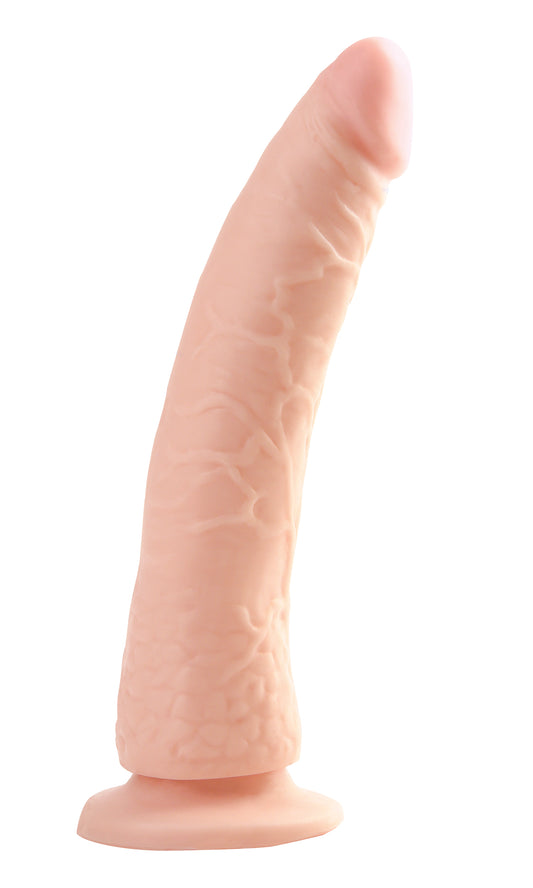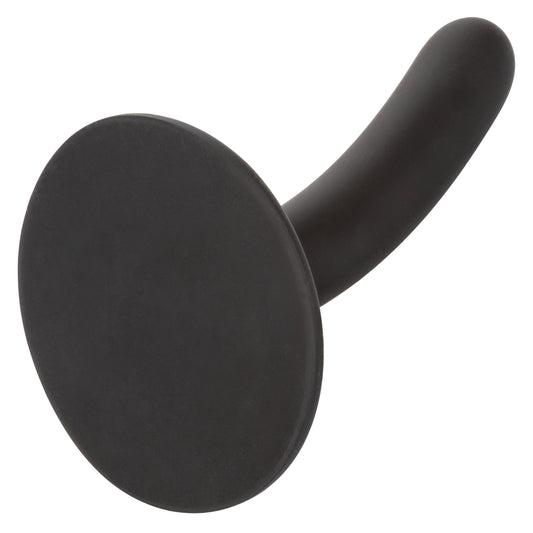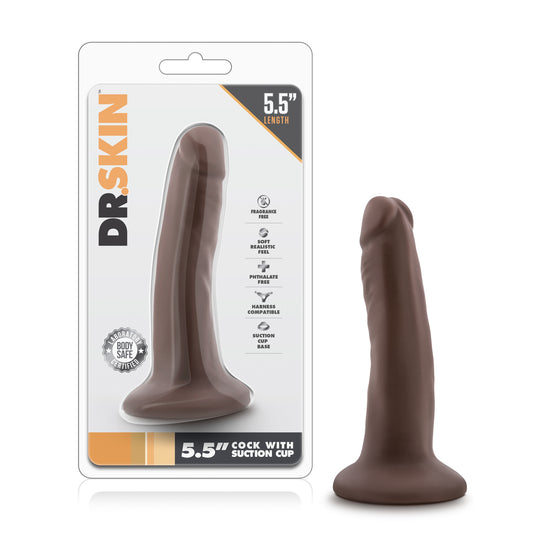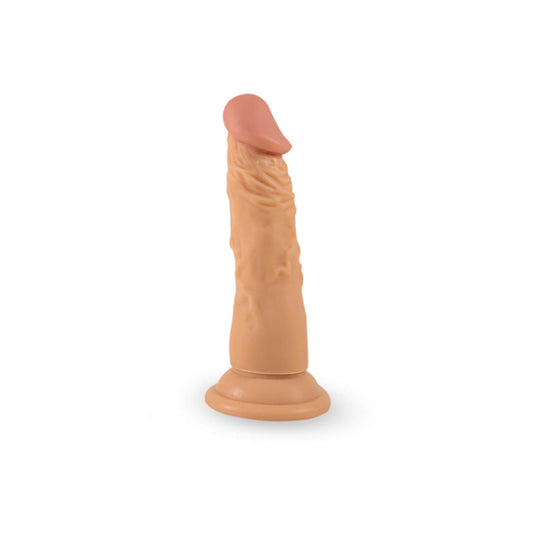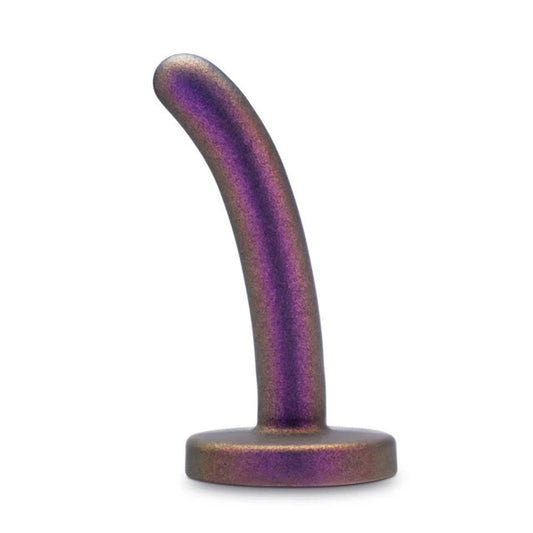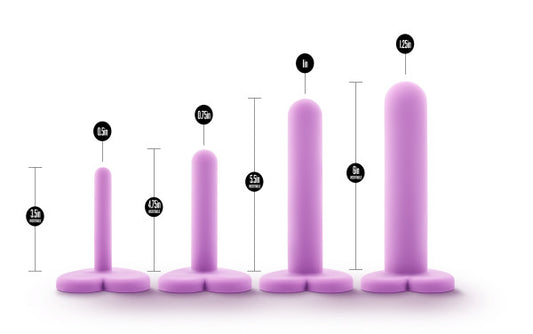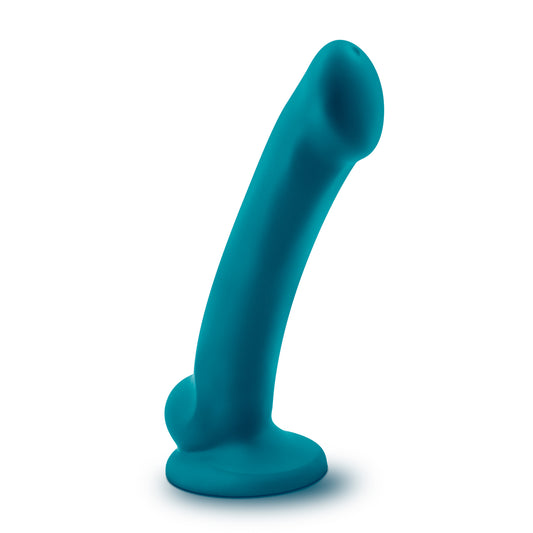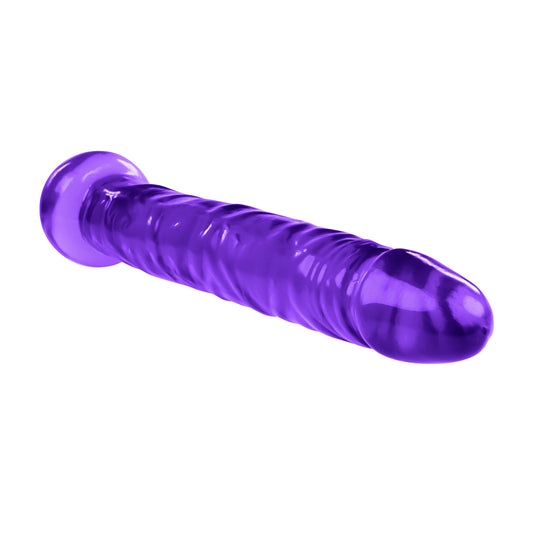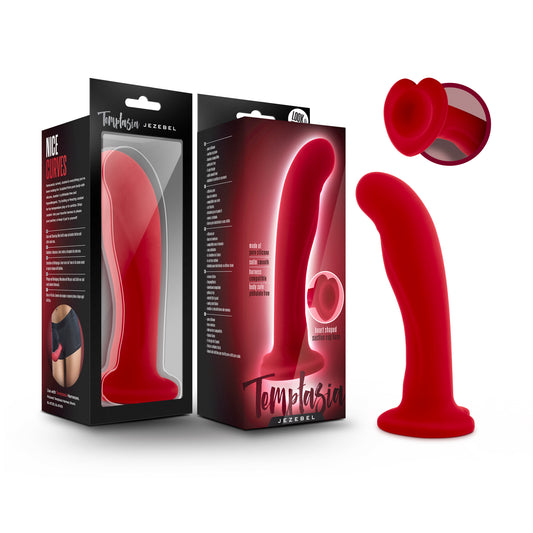First Dildo Guide: Pain-Free Size, Shape, and Use for Beginners
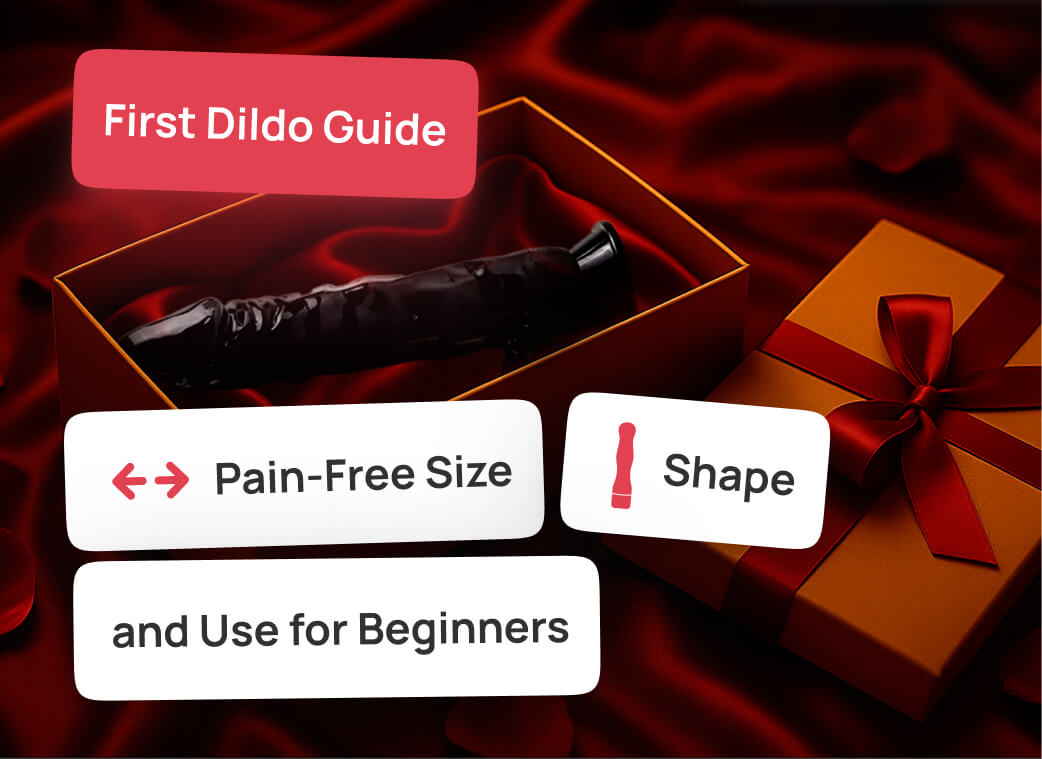
Content
What Is a Dildo?
A dildo is a non-powered insertable sex toy designed for internal stimulation. Materials are typically nonporous like silicone, glass, or stainless steel, because they’re easier to clean and feel predictable. Paired with water-based lube, they minimize friction and help first-timers learn control safely.
What Size Is Safe for Your First Dildo?
Start small on girth (circumference/diameter) and moderate on length: comfort is governed mostly by stretch at the entrance, so a slim starter dildo is the safest first step. For most beginners, “small” on retailer size charts clusters around ~1.0–1.25 in diameter (≈ 2.5–3.2 cm) or ~3.1–3.9 in circumference (≈ 8–10 cm), with ~4–6 in (≈ 10–15 cm) insertable length.
What Girth/Diameter Works Best At The Start?
Choose a slim diameter because the vaginal or anal opening senses stretch, not depth; length is secondary until stretch feels comfortable. Think shoe width vs. length: you can tolerate extra toe room, but the wrong width pinches immediately.
- Diameter: ~1.0–1.25 in (2.5–3.2 cm) is a common beginner range; 1.5 in (3.8 cm) is a typical “upper edge” once you’re comfortable.
- Circumference (≈ π·d): 1.0 in → 3.14 in (8.0 cm); 1.25 in → 3.93 in (10.0 cm); 1.5 in → 4.71 in (12.0 cm).

Do You Need a Tapered Tip, And How Does It Change First Insertion?
Yes—a tapered tip (narrower at the end) reduces the initial stretch and helps the pelvic floor relax, so the first centimeters feel calm and controllable. The compromise is that you get less immediate fullness up front; many best beginner dildos use a long, gradual taper for exactly this reason.
How Do You Know the Size Is Too Big Right Now?
If you feel sharp pain, burning, or your body “guards” (clenching, breath holding), the diameter is likely too large for today or you’re going too fast with too little lube. Step down in girth, slow the tempo, and switch to a water-based lubricant—it’s universally compatible with silicone toys and reduces friction, which ACOG notes can make penetration more comfortable.
Across first-timer consults we see a pattern: a 1.5-in (3.8 cm) starter often causes burning at shallow depth. Reducing to ~1.2-in (3.0 cm) with a tapered tip, adding water-based lube, and halving tempo typically drops discomfort to zero within ~60 seconds and allows a steady 5–10 minute session.
[prod_1][prod_2][prod_3]
How Do You Choose Your First Dildo?
Start with slim girth, smooth surface, and simple features: a beginner dildo that’s small, body-safe, and easy to control teaches you mechanics without pain or overwhelm.
Core Criteria for Beginner Dildos
Pick with intent, not vibes—use this short checklist to avoid trial-and-error.
- Girth (primary fit): For most first-timers, a slim dildo feels safest (e.g., ~1.0–1.25 in / 2.5–3.2 cm). Smaller girth lowers entrance stretch; you can size up later.
- Tapered Tip: A gradual taper makes initial insertion calmer by easing the first centimeters; the trade-off is less immediate fullness.
- Body-Safe Material: Nonporous silicone is forgiving and grippy enough to control; glass/steel are ultra-smooth and precise but feel firmer and heavier.
- Lube Pairing: Default to water-based (toy-compatible, easy to reapply; studies show it’s safer, lower-friction). Avoid pure silicone on silicone toys.
- Base & Safety: Flared base = non-negotiable for anal play; optional for vaginal-only use. A suction cup adds hands-free options if you’ll use smooth surfaces.
- Scenario Fit: Solo learning favors smaller, simpler shapes; partner play might benefit from a model that’s harness-compatible (even if you won’t use a harness yet).
- Care: Fewer seams and fully nonporous materials simplify cleaning; store dry and separate from other toys to protect surfaces.
| Diameter (in) | Diameter (cm) | Circumference (in) | Circumference (cm) | Band / Note |
|---|---|---|---|---|
| 0.70 | 1.78 | 2.20 | 5.6 | Narrow mini / warm-up |
| 0.75 | 1.91 | 2.36 | 6.0 | Narrow mini / warm-up |
| 0.80 | 2.03 | 2.51 | 6.4 | Narrow mini / warm-up |
| 0.90 | 2.29 | 2.83 | 7.2 | Very slim (high-anxiety start) |
| 1.00 | 2.54 | 3.14 | 8.0 | Beginner sweet spot |
| 1.10 | 2.79 | 3.46 | 8.8 | Beginner sweet spot |
| 1.20 | 3.05 | 3.77 | 9.6 | Starter (wider) |
| 1.25 | 3.17 | 3.93 | 10.0 | Upper beginner edge → prefer tapered tip |
| 1.30 | 3.30 | 4.08 | 10.4 | Emerging intermediate |
| 1.40 | 3.56 | 4.40 | 11.2 | Emerging intermediate |
| 1.50 | 3.81 | 4.71 | 12.0 | Step-up threshold |
| 1.60 | 4.06 | 5.03 | 12.8 | Intermediate |
| 1.75 | 4.45 | 5.50 | 14.0 | Intermediate–large |
| 2.00 | 5.08 | 6.28 | 16.0 | Large |
Will It “Grow with You”? Signs Your Choice Won’t Be Obsolete in a Month
Choose modestly small, not tiny, and add one future-proof feature so the toy stays useful as you progress. Good “growth” signs: a tapered-to-moderate shaft (comfortable now, fuller mid-section later), suction-cup base (adds positions), harness-compatible flange, and material that tolerates thorough cleaning for long-term hygiene.

Which Material Is Most Beginner-Friendly for Dildos?
For sex toys for beginners, soft-touch silicone with water-based lube balances comfort and control; glass or stainless steel give ultra-smooth glide and precise pressure—just use a slower tempo.
Silicone Vs Glass Vs Steel—What’s Easier to Control For a First-Timer?
Silicone feels slightly cushioned and grippy, so it’s forgiving when you’re learning angles; glass/steel are rigid and ultra-low-friction, great for precision but less forgiving if you rush. So, choosing silicone buys comfort and control, but you’ll reapply lube more often; choosing steel/glass dildos buys effortless glide and targeted pressure, but demands gentler pacing and temperature awareness (they take on room or body heat).
Which Lubes Are Compatible with Dildos?
Use water-based lube for a beginner dildo: it’s universally compatible with silicone toys, easy to wash off, and simple to refresh mid-session. Compatibility snapshot:
- Silicone toys: water-based (safe), many hybrids (usually fine), pure silicone lubes often discouraged (can interact with some silicones).
- Glass/steel: water-based or silicone lube both work; test small amounts first; clean thoroughly to avoid residue. Engineering compromise: water-based dries faster (you’ll reapply), but in exchange you avoid material incompatibility and keep cleaning quick.
When Firm Materials Help Precise G/P-Spot Pressure
If your goal is “find the spot and press exactly there,” a curved glass or steel shaft delivers focused pressure with minimal bend—like swapping a foam paint roller (silicone) for a stainless pastry roller (steel): less give, more line control. Start smaller, warm the toy to body temp, and use plenty of lube.
[prod_4][prod_5][prod_6]
Which Shape and Features Help You Hit the Right Spot from Day One?
Pick shape for the job! Straight teaches angle and depth control; curved simplifies G-spot or P-spot targeting. Features like suction cups and flared bases expand where and how you can play, and harness-compatibility keeps options open for later.
Straight Vs Curved For G-/P-Spot—What’s Easier for Beginners?
If you’re learning mechanics, a straight, slim shaft is the easiest to steer. For targeted internal spots, a gentle curve helps you angle up toward the anterior wall (G-spot) or forward toward the prostate.
Straight = simpler and less likely to poke unexpectedly. Curved = faster to “find it,” but can feel bigger at the bend—keep girth modest.
When Does a Suction Cup Actually Help?
A suction-cup base helps when you want hands-free stability on smooth, non-porous surfaces (tile, sealed wood, acrylic, glass) or to hold a predictable angle while you adjust hips and breathing. But porous/uneven surfaces break the seal, and stronger cups still need clean, flat contact. If you’ll only use the toy in bed, you may not need a suction cup dildo at all.
What Is a Flared Base, And When Is It Non-Negotiable?
A flared base is a wide stop-flange that prevents the toy from traveling too deep; it’s mandatory for anal play and optional for vaginal-only use.
Rule of thumb: For anal dildos for beginners, a flared base is the baseline safety feature—treat it as non-optional.
What Does “Harness-Compatible” Mean?
“Harness-compatible” means the base is flat and wide enough to sit securely in a strap-on harness (often through a circular O-ring) without wobbling or slipping through. You don’t have to buy a new toy if you later try partner play. The compatibility future-proofs your starter dildo while keeping the learning curve gentle today.

How to Use a Dildo for The First Time Without Pain or Stress?
Go slow, aroused, and well-lubed, and keep the angle shallow at the entrance; sharp pain, numbness, or tingling are stop signs, not milestones. The goal of a first-time dildo session is control and comfort first, sensation later.
Prep That Truly Reduces Discomfort (Arousal, Warm-Up, Breathing)
Get the pelvic floor to let you in before you try to go in.
- Arousal first (6–7/10): Warm hands, external touch, and clitoral/perineal stimulation reduce guarding far more than forcing depth early.
- Warm-up: With water-based lube, start with a fingertip (vaginal) or a small, flared-base plug (anal). Spend 3–5 minutes exploring the entrance only.
- Breathing cue: Insert on the exhale; a slack jaw (quiet “haaa”) mirrors pelvic floor release.
- Angle plan: Begin with the shaft roughly toward the navel (vaginal, anterior wall/G-spot) or slightly forward toward the belly (anal) so the tip doesn’t poke posteriorly.
How Much Lube Is Enough and How to Reapply Mid-Session
Use more than you think: start with 2–3 ml (about two pumps) of water-based lube on both the entrance and the toy, then add 1–2 ml whenever glide dulls.
- Top-ups: Reapply when you hear squeakiness, feel tackiness, or sense heat from friction. A spritz of water reactivates many water-based gels.
- Texture choice: Thicker gel = stays put at the entrance; thinner liquid = spreads fast but needs more frequent top-ups.
More lube slightly mutes fine texture cues—that’s normal for beginners; you’ll chase detail later.
Beginner-Friendly Positions/Angles That Tend To Work First
Pick positions that reduce entrance stretch and let you steer angle in small increments.
- On back, knees up, pillow under hips (vaginal): Angle the tip up toward the navel to meet the anterior wall (G-spot route).
- Side-lying (both): The pelvic floor is quieter; tiny angle changes are easy. Keep strokes short (1–2 cm) until burn = 0.
- Edge of bed, feet on floor (vaginal): Hips stable, hands free to guide; think 30–45° upward tilt for a curved shaft.
- Anal basics: Start side-lying with small diameter and copious lube; breathe out on each 0.5–1 cm advance.
On surfaces where a suction cup holds, experiment with different ways to ride a dildo at shallow angles before increasing depth. There are some stop signals you need to be aware of:
- Sharp/burning pain that doesn’t fade in a breath or two.
- Numbness/tingling or spasm/clenching you can’t relax out of.
- Light-headedness or breath-holding.
If any of this happens - withdraw, add lube, reduce girth, slow to half-tempo, and re-enter with a tapered tip at a shallower angle. If pain persists after all these steps, check in with a pelvic-health clinician or pelvic floor physical therapist (find one via trusted sources, for example APTA’s Pelvic Health PT Locator (U.S.)) and review expert resources on sexual pain.
[prod_7][prod_8][prod_9]
How Do You Clean and Store Dildos Safely?
Clean right after use, dry completely, and store separately; if you switch between anal and vaginal use, barrier or full clean between—not after.
Washing Silicone, Glass, Steel
For solid, non-porous toys (no motors):
- Rinse warm water to remove lube/fluids.
- Unscented soap + fingers/palm (no scratchy tools) for 20–30 s.
- Thorough rinse—no suds left in seams or around the base.
- Occasional deep clean: many solid silicone, glass, and stainless-steel toys tolerate a short boil (~3 min); skip this if the sex toy is painted, vacuum-plated, or if the manufacturer advises against it. Soap-and-water is sufficient for routine care.
Boiling sanitizes well but ages some finishes over time, routine gentle washing preserves surfaces.
Can One Dildo Be Used Both Anally and Vaginally?
It’s safest to designate separate toys. If you must switch in one session, use a new condom on the toy and wash thoroughly before changing direction.
- Non-negotiable: flared base for any anal use.
- Sequence: don’t go anal → vaginal without a barrier change + wash.
Drying And Storage to Avoid Damage, Odors, Dust
Air-dry fully or use a lint-free towel; moisture + closed pouches = odor and biofilm risk.
- Store separately in a breathable pouch; avoid direct sun, extreme heat, and toy-to-toy contact (especially silicone with PVC/TPE).
- Suction cups: let the cup dry fully before sticking it to anything for storage; prolonged compression can deform the rim.

Should You Start Solo or Bring in a Partner Right Away?
Most first-timers learn faster solo. You control pace, angle, and lube, then bring your partner in once you know what works and what hurts for you.
Why Solo Practice Lowers Anxiety and Helps You Find Your Angle
Solo sessions remove performance pressure and let you map sensations with tiny adjustments. Aim for short, curiosity-driven sessions (5–10 min) with a slim, tapered starter dildo; note the angle and depth where burn drops to zero and pleasure begins.
How To Invite a Partner in Without Pressure
Agree on signals and roles before any insertion.
- Signals: simple “red/yellow/green” or “pause/softer/ok.”
- Receiver leads: your hand on the base sets angle and depth; partner provides steady support, not thrusting.
- Tempo: start at half the solo pace; speak in specifics (“shallower,” “angle up 10°,” “more lube now”).
Is A Vibrating Dildo Better for Beginners?
For most beginners, a non-vibrating starter dildo is the cleaner way to learn angle, depth, and how to insert a dildo without pain. A beginner vibrator can be added later for comfort or extra arousal. The trade-off is simple: vibration may relax you, but it can also mask feedback you need to calibrate mechanics.
When Vibration Helps Relaxation Vs When It Overwhelms Learning
Vibration helps when anxiety is high, arousal is low, or external stimulation (e.g., clitoral) keeps your pelvic floor from guarding—great for a first session of how to use a dildo for the first time. On the other side, it overwhelms when the buzz steals your attention, you chase intensity instead of checking angle, girth, and lube, or you over-thrust because the surface feels “too easy.”

If you haven’t yet achieved painless insertion, 1–2 cm short strokes without burning, and basic angle control, keep vibration off and master those fundamentals. Once those boxes are ticked, add low speed vibration (think “training wheels”) and reassess: if control stays steady and comfort holds, you’re ready to explore best ways to use a dildo with vibration.
Troubleshooting: What If Something Goes Wrong?
Almost every problem during first-time dildo use maps to girth, lube, or angle—and all three are fixable mid-session. Make one change at a time and retest after two slow breaths.
Burning Or Pain
First, stop. Then: add water-based lube, halve depth, and rotate angle a few degrees (vaginal: tip slightly toward the navel; anal: slightly forward toward the belly). If burning persists, downsize girth or switch to a tapered tip. Next session, choose a small dildo for beginners (≈ slim diameter), extend warm-up by 3–5 minutes, and keep early strokes under 1–2 cm.
“I Feel Nothing”
Lack of sensation usually means wrong angle or too long a stroke. Try a curved beginner dildo and aim anterior (vaginal G-spot route) or forward (prostate route) with short, rhythmic pulses. Use positions with fine steering—side-lying or edge of bed—and note the angle where sensation appears; that’s your baseline for a best beginner dildo session.
Sticky/Dusty Surfaces or Residue
Sticky feel = dried lube or soap residue. Wash with unscented soap, rinse thoroughly, and air-dry before storing. For silicone, dust pickup means it wasn’t fully dry or is stored against other materials; keep it in a breathable pouch, separate from PVC/TPE. If water-based lube gets tacky mid-session, reapply 1–2 ml or spritz water to reactivate.
When Is a Dildo Not the Best First Toy?
If penetration triggers anxiety, guarding, or pain, starting with external vibration can be a smoother on-ramp than any dildo for beginners. You’ll build arousal and confidence first, then return to starter dildos with a calmer body.
External toys stimulate nerves at the surface without stretch, so you can learn what arousal feels like at 6–7/10 before adding insertion. Yes, you won’t practice angle/depth mechanics yet, but you’ll reduce fear—and that’s decisive for many “buying my first dildo” journeys.
You can also choose external vibration first if you’ve had painful penetration, pelvic floor spasm, childbirth-related tenderness, or intense performance anxiety. In these cases, the best first toy is the one that builds trust; a dildo for beginners can follow once comfort is reliable. Persistent pain warrants a check-in with a pelvic-health professional.
Final Thoughts
We hope you found this helpful. Remember: start small on girth, use plenty of water-based lube, keep angles shallow, and stop on sharp pain—comfort beats depth every time. You’ve got this—go at your pace and only add shape or vibration when it feels right!

